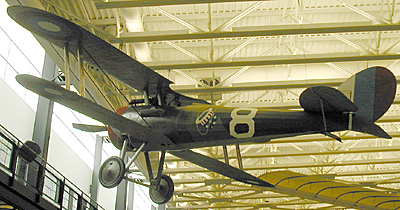 Having exhausted all the possibilities for variations to the Type 17 airframe, Nieuport produced a totally new aircraft which it designated the Type 28. This marked a break from the V-strut sesquiplane configuration of the earlier Nieuport scouts, which was replaced by wings of almost equal proportion braced by parallel struts. The rectangular section fuselage was superseded by one of circular section, fitted around a new 160hp (119kW) Gnome-Le Rhone 9N engine. The Type 28 was ordered into production almost off the drawing board, but in service from March 1918 the Gnome engine proved to be its Achilles' heel, proving itself totally unreliable. A further failing was that at high speed any violent manoeuvre tended to rip the fabric from the upper wing. Notwithstanding these problems, the Type 28 happened to be the only fighter readily available to the US Expeditionary Force, the Pursuit Squadrons of which began arriving in France in early 1918.
Having exhausted all the possibilities for variations to the Type 17 airframe, Nieuport produced a totally new aircraft which it designated the Type 28. This marked a break from the V-strut sesquiplane configuration of the earlier Nieuport scouts, which was replaced by wings of almost equal proportion braced by parallel struts. The rectangular section fuselage was superseded by one of circular section, fitted around a new 160hp (119kW) Gnome-Le Rhone 9N engine. The Type 28 was ordered into production almost off the drawing board, but in service from March 1918 the Gnome engine proved to be its Achilles' heel, proving itself totally unreliable. A further failing was that at high speed any violent manoeuvre tended to rip the fabric from the upper wing. Notwithstanding these problems, the Type 28 happened to be the only fighter readily available to the US Expeditionary Force, the Pursuit Squadrons of which began arriving in France in early 1918.
Country of origin: France
Type: single-seat fighter
Powerplant: one 160hp (119kW) Gnome-Le Rhone 9N rotary piston engine
Performance: maximum speed 195km/h (121mph); service ceiling 5200m (1 7,060ft); range 400km (248 miles)
Weights: empty 532kg (11721b); maximum take-off weight 740kg (16311b)
Dimensions: span 8m (26ft 3in); length 6.2m (20ft 4in); height 2.48m (8ft 2in); wing area 20 sq m (215 sq ft)
Armament: two fixed forward-firing .303in Vickers machine guns
Text from: Biplanes, Triplanes, and Seaplanes by Michael Sharpe (Fiedman/Fairfax, 2000, ISBN: 1-58663-300-7), a handy book with specs for 300 aircraft.
WWI
WWII
Japan: Kawanichi N1K2-Ja Shinden Kai (George)
US: Curtiss P40 Tomahawk
Post WWII
US: Northrop N-1M Flying Wing
Other
UHC Displays
Germany: Focke-Wulf FW-190F
Germany: Arado AR-234B
Germany: Junkers JU-52/3m
Germany: Focke-Achgelis FA-330A
Germany: Rheintochter R1 Anti-aircraft Missile (Rhine Maiden)
Japan: Kawasaki Ki-45 Kai Toryu (Nick)
Japan: Aichi M6A1 Seiran
Japan: Kugisho Ohka Model 22 Cherry Blossom
US: Vought F4U Corsair
US: Lockheed P-38J Lightning
US: Boeing B-29 Superfortress "Enola Gay"
US: Grumman F6F Hellcat
US: Republic P-47D Thunderbolt
UK: DeHavilland DHC-1A Chipmunk
US: Lockheed SR-71 Blackbird
US: Space Shuttle "Enterprise"
US: Lockheed Martin X35b Joint Strike Fighter
Back to List of Historic Sites
Back to Travel Master List
Back to MagWeb Master List of Magazines
© Copyright 2004 by Coalition Web, Inc.
This article appears in MagWeb.com (Magazine Web) on the Internet World Wide Web.
Other articles covering military history and related topics are available at http://www.magweb.com